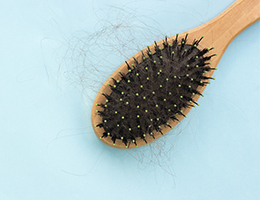
You've noticed that your hair appears to be getting thinner. And where you part your hair, more scalp is showing than before.
Are you losing your hair?
We tend to associate hair loss with men, not women. But women can have hair loss too. It's called androgenetic alopecia—or female pattern hair loss (FPHL). It happens to millions of women, but that doesn't make it any less distressing when it happens to you.
FPHL is the most common cause of hair loss in women. It usually begins in your 40s, 50s or 60s. And the condition is hereditary. But instead of the balding crown typically seen in men with hereditary hair loss, you may see your hair thinning all over.
That doesn't mean you can't do anything about your loss of locks. Your first step, however, is to see a dermatologist, preferably one who specializes in FPHL.
What are my treatment options?
A dermatologist can tell you if you have FPHL or some other condition with similar symptoms. If you have FPHL, multiple therapies are available that may help.
Topical minoxidil. Exactly how minoxidil works isn't known. But it is the first-line treatment for FPHL. A number of studies have found that women using minoxidil were more likely to see significantly more hair regrowth than women using a placebo product.
It's important to know that you may see an increase in hair loss in the first weeks of applying minoxidil to your scalp. This is normal and it stops when your hair begins to regrow. If minoxidil works well for you, you'll have to keep applying it or your hair loss will return.
You can't use minoxidil if you're pregnant or breastfeeding. It could prove harmful to your baby. Otherwise, minoxidil is considered a relatively safe treatment.
Prescription medications. Spironolactone has been used for many years to restore hair growth and stop hair loss from getting worse. It can be used in combination with minoxidil.
Other medications that may be helpful include finasteride, flutamide and dutasteride.
All these prescription medications can cause birth defects, so it's important to avoid them if you plan on becoming pregnant.
Hair transplantation. In this procedure, hairs are surgically removed from unaffected areas on the scalp and transplanted in thin or balding areas. This might not be an option for you if your hair is thinning all over.
Low-level laser light therapy. This is a nonprescription, at-home treatment that has been used on men with hereditary hair loss. The U.S. Food and Drug Administration has approved laser combs, helmets and other laser devices that may help stimulate hair growth.
Dietary supplements. Reports on the effectiveness of dietary supplements are mixed at best. But you might want to ask your dermatologist about using these supplements to help grow and thicken hair:
- Antioxidants.
- Biotin.
- Folic acid.
- Omega-3 and omega-6 fatty acids.
Hair loss shampoos. These cannot regrow hair or prevent hair loss. But they may be able to reduce breakage and help your hair look fuller and thicker.
Make an appointment
If you think you're experiencing hair loss, make an appointment with a dermatologist as soon as you can. Treatment works best when it's started early.
Reviewed 11/14/2023